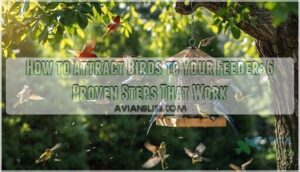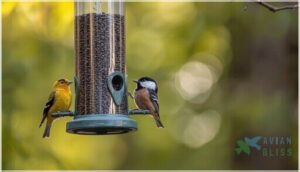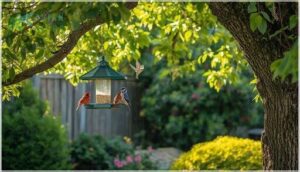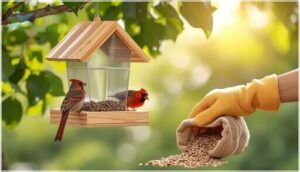This site is supported by our readers. We may earn a commission, at no cost to you, if you purchase through links.
You hang a bird feeder in your yard, fill it with seed, and wait. Days pass. A week goes by. Still no birds. The problem isn’t patience—it’s strategy. Birds won’t visit feeders placed in the wrong spot, filled with unappealing food, or positioned where they feel exposed to predators.
The good news? Once you understand what birds need to feel safe and why certain seeds work better than others, you can turn an empty feeder into a bustling avian hub. Small adjustments to feeder type, placement, and food selection make the difference between a lonely perch and a backyard filled with chickadees, finches, and woodpeckers.
Table Of Contents
- Key Takeaways
- Choose The Right Bird Feeder
- Select The Best Feeder Location
- Offer The Most Appealing Bird Foods
- Keep Feeders Clean and Food Fresh
- Create a Bird-Friendly Habitat
- Attract Specific Bird Species to Your Feeder
- Frequently Asked Questions (FAQs)
- How do I attract birds to my garden?
- How to attract more birds to your feeder?
- How do you get birds to eat a bird feeder?
- How do I attract squirrels to my bird feeder?
- How can I make birds come to my bird feeder?
- How long does it take for a bird feeder to attract birds?
- Why am I not getting birds at my bird feeder?
- What attracts birds the most?
- How can I deter squirrels from feeders?
- What types of feeders attract hummingbirds?
- Conclusion
Key Takeaways
- Strategic feeder placement 10-12 feet from cover balances predator avoidance with bird safety, while black oil sunflower seeds attract the widest variety of species due to their high fat and protein content.
- Regular cleaning every 1-2 weeks with a 10% bleach solution prevents disease transmission that can cause regional bird die-offs, and replacing moldy seed within 48 hours maintains bird health.
- Creating a complete habitat with native plants, fresh water sources, and nesting materials attracts twice as many birds as feeders alone while supporting natural breeding and migration patterns.
- Species-specific strategies like using tube feeders with nyjer seed for finches or suet cages for woodpeckers can increase targeted bird visits by 40-86% compared to generic feeding approaches.
Choose The Right Bird Feeder
Your feeder choice shapes which birds will visit your yard. Different designs cater to specific feeding behaviors—some birds prefer open platforms, while others feel safer clinging to tubes or mesh.
Let’s look at the main feeder types and which species they attract best.
Platform Feeders for Versatile Species
Platform feeders are your best bet for drawing in a crowd—they attract nearly 90% of feeder-visiting species, from cardinals and blue jays to mourning doves and goldfinches. You can mount them on railings, posts, or hang them up, and they accommodate everything from seeds and suet to fruit slices.
Choose screened bottoms for drainage and covered designs to keep seed dry. Using the right bird feeder types can greatly improve your bird-watching experience.
Tube Feeders for Small Songbirds
Tube feeders work beautifully for finches, chickadees, and nuthatches—birds that naturally cling while feeding. Look for designs with 4 to 8 ports and short perches that keep out larger species. Fill them with black oil sunflower seeds or nyjer seeds, and hang them at least 5 feet high near cover.
Clean every 1–2 weeks to prevent mold and disease spread. For best results, consider using suet feeder types to attract a variety of bird species.
Suet and Thistle Feeders for Specialty Birds
If you want to attract woodpeckers, chickadees, and finches, specialty feeders make all the difference. Suet cakes deliver up to 9,000 calories per kilogram—perfect for cold-weather energy. Wire cage suet feeder designs keep out larger birds while welcoming over 20 species.
Thistle seed feeders with fine mesh target finches specifically, with nyjer seeds offering 35% fat content. These bird feeding strategies boost diversity and reduce waste.
Squirrel-Proof and Pest-Resistant Feeders
Squirrels can devour 40% of your seed at unprotected sites. Weight-activated squirrel-proof feeders with smooth surfaces solve this—their ports close automatically when pests land. Capsaicin-treated seed cuts squirrel feeding time by 66% without affecting bird visitation.
Squirrels steal 40% of seed at unprotected feeders, but weight-activated designs and capsaicin treatments dramatically reduce losses
Install dome baffles below your bird feeder to block 90% of rodent access.
Modern feeder designs using eco-friendly materials now integrate these pest deterrents while maintaining bird safety.
Select The Best Feeder Location
You’ve picked the perfect feeder, but it won’t do much good if birds can’t find it or don’t feel safe using it. Location matters just as much as the feeder itself—maybe even more.
Let’s walk through the key placement strategies that’ll turn your yard into a bustling bird haven.
Place Feeders Near Plant Cover for Safety
You’ll want to position your bird feeder within 10 to 12 feet of shrubs or trees—close enough for quick escape routes, but not so near that predators can ambush from dense cover. This strategic feeder placement balances bird safety with predator avoidance.
Dense plant cover reduces stress and collision prevention risks, creating bird-friendly habitats that support wildlife-friendly gardening and better bird feeding tips overall.
Position for Maximum Visibility to Birds
To boost bird visibility, position your bird feeder in an open area with clear sky above—this helps backyard birds spot it easily from their flight paths. Place the feeder 10 to 12 feet from tree cover for ideal bird watching and collision prevention.
Morning sunlight with afternoon shade creates the right sunlight balance, keeping seeds fresh while attracting birds to gardens naturally.
Avoid Predator-Prone and High-Traffic Areas
Beyond visibility, bird safety depends heavily on smart predator avoidance and traffic reduction. Hawks, cats, and raccoons hunt where birds congregate, while vehicle noise disrupts natural behavior and ecology.
Follow these feeder placement guidelines for maximum bird safety:
- Position feeders at least 30 feet from busy roads and driveways
- Avoid dense cover that conceals stalking predators
- Keep feeders away from ground-level ambush spots
- Install baffles on poles to deter climbing predators
- Create birdfriendly habitats with open sightlines around squirrelproof feeders
Strategic habitat design and bird feeder maintenance protect your feathered visitors while encouraging natural feeding patterns.
Adjust Feeder Height for Target Species
Feeder height directly influences which bird species visit your yard and how safely they feed. Cardinals and finches thrive at 5 to 6 feet, while woodpeckers prefer 6 to 10 feet—matching their natural foraging zones. Ground feeders like sparrows feed between 1 to 5 feet. Higher placement improves predator avoidance and bird visibility.
Seasonal adjustments in your bird feeding strategies can maintain diversity throughout the year.
Offer The Most Appealing Bird Foods
The right food makes all the difference when you’re trying to bring birds to your yard. Different species have different tastes, so offering a variety gives you the best chance of attracting a mix of visitors.
Here are four types of bird foods that consistently draw hungry feathered friends to feeders.
Black Oil Sunflower Seeds for General Attraction
If you’re serious about attracting the widest variety of birds, black oil sunflower seeds are your best bet. Cardinals, chickadees, and finches can’t resist them.
These birdseed favorites pack 49 grams of fat and 21 grams of protein per 100 grams—critical for wild bird health, especially during bird migration and winter.
Proper feeder placement near cover maximizes sunflower benefits, while their premium seed nutrition outperforms most seed mixes in effective bird feeding strategies.
Nyjer and Thistle Seeds for Finches
Finches show a clear preference for nyjer over thistle seed—the higher oil content delivers more energy, especially during cold months. Here’s what you need to know about finch nutrition and seed preferences:
- Nyjer’s soft texture and energy density make it the top choice for goldfinches and siskins.
- Use specialized finch feeders with small ports to reduce waste.
- Replace nyjer every 2-3 weeks—high oil content means faster spoilage.
- Store bird seed in airtight containers to maintain freshness and support bird health.
Proper feeder maintenance prevents mold growth that can harm your feathered visitors.
Suet Cakes for Woodpeckers and Chickadees
While finches prefer tiny seeds, woodpeckers and chickadees need something richer. Suet cakes pack double the calories per gram compared to protein alone—that’s why they’re essential for cold-weather survival.
Look for blends with at least 9–10% crude protein and peanuts to boost woodpecker visits. Mesh or cage suet feeders work best, letting clinging birds feed comfortably while keeping larger species out.
Fresh Fruits and Mealworms for Variety
Beyond seed and suet, fresh fruits and mealworms open your feeder to insectivorous birds like bluebirds and robins. Orioles love orange halves on platform feeders, while live mealworms outperform dried ones for attracting Eastern Bluebirds.
- Offer grapes, cherries, and berries during migration
- Remove uneaten fruit daily in warm weather
- Use shallow dishes for mealworms
- Clean fruit feeders with each refill
- Store mealworms in wheat bran for longevity
Keep Feeders Clean and Food Fresh
A dirty feeder can spread disease among birds faster than you’d think. Regular cleaning and fresh food aren’t just nice touches—they’re essential for keeping your feathered visitors healthy and coming back.
Here’s how to maintain your feeders the right way.
Clean Feeders Every 1-2 Weeks
Regular feeder maintenance protects bird health and keeps your backyard birding tips effective. Clean your bird feeder every one to two weeks using a 10% bleach solution—this disease prevention step greatly reduces bacterial infections and coccidiosis.
During warm weather or high traffic periods, increase your cleaning schedules to weekly. Proper feeder sanitation through consistent feeder maintenance prevents outbreaks that have caused regional die-offs, making it essential for bird conservation methods.
Replace Old or Moldy Seed Regularly
Keeping feeders spotless is just one part of the equation—what you put inside matters just as much.
Check your birdseed every 2-3 days for mold prevention and spoilage control. Toss any clumped or discolored seed immediately, since moldy feed causes respiratory illness and salmonellosis in wild birds.
Fill your bird feeder with only what birds eat within 48 hours for ideal bird health and feeding strategies.
Use Proper Cleaning Solutions
Two effective disinfectant options keep your feeder sanitation protocols strong: a 10% bleach solution (1 part bleach to 9 parts water) or white vinegar mixed 1:1 with water.
Soak feeders for 10 minutes in bleach or 60 minutes in vinegar for proper disease prevention.
Rinse thoroughly—2-3 times—to protect bird health and confirm no harmful residues remain before refilling.
Store Birdseed in Airtight Containers
Proper seed storage tips protect your investment and your birds’ health. Store birdseed in airtight containers—steel, aluminum, or thick plastic work best—to prevent mold growth that can sicken visiting bird species.
These containers keep moisture out, block rodents and insects, and maintain freshness for months. You’ll see airtight container benefits immediately: fresher seed means healthier birds and fewer wasted dollars on spoiled feed.
Create a Bird-Friendly Habitat
A feeder alone won’t turn your yard into a bird haven. You need to create a welcoming environment that offers food, water, shelter, and nesting opportunities all in one place.
Here are four ways to make your outdoor space irresistible to birds.
Plant Native Trees, Shrubs, and Flowers
Think of native plants as the foundation of your backyard bird sanctuary. When you establish native shrubs, trees, and flowers, you create bird habitat restoration that truly works. Here’s what to plant for bird-friendly landscaping:
- Native oaks—supporting over 500 caterpillar species for baby birds
- Spicebush—offering high-fat berries for migratory energy
- Trumpet honeysuckle—attracting hummingbirds year-round
- Native cherry trees—sustaining 448 moth species
- Winterberry holly—providing seasonal food sources
This eco-friendly gardening approach aids local species naturally.
Provide Dense Cover and Shelter
Birds need protective cover to feel safe visiting your feeder—without it, predator control becomes impossible. Position feeders within 3.5 meters of dense shrub placement like evergreen hollows or native landscaping features.
This bird-friendly habitat creation reduces predation by up to 95% while supporting wildlife-friendly gardening goals. Dense bird habitat offers escape routes during hawk attacks and weather protection, essential for bird safety and successful bird-friendly landscaping.
Offer Water Sources Like Birdbaths or Drippers
Clean, moving water attracts twice as many visitors as feeders alone—essential for bird hydration and feather maintenance. Here’s how to create effective water features for wildlife-friendly gardening:
- Install a shallow birdbath (2-5 cm deep) with textured surfaces for safe perching and diverse bird behavior and ecology.
- Add dripper systems to create movement, improving water quality while preventing mosquito breeding.
- Position your bird bath in shade near cover to reduce predation risk.
- Refresh water daily to maintain fresh water standards and prevent disease transmission.
Supply Nesting Materials Nearby
Want to boost nesting success in your backyard habitat? Position safe nesting material stations 10-15 feet from feeders—keeping them separate reduces predation risk while supporting bird behavior and ecology.
Offer untreated grass clippings, moss, pine needles, and sheep wool in sheltered spots near birdhouses or nesting boxes.
This simple gardening for wildlife strategy helps birds build stronger nests and increases local breeding activity.
Attract Specific Bird Species to Your Feeder
Once you’ve built a welcoming environment, you can fine-tune your approach to bring in the exact birds you’re hoping to see.
Different species have distinct preferences for food, feeder style, and timing throughout the year. Here’s how to target specific visitors and keep them coming back.
Research Local Birds and Their Preferences
Your backyard isn’t the same as your neighbor’s regarding bird species. Project FeederWatch data from over 25,000 observers reveals clear regional patterns—135 species regularly visit feeders, but local diversity varies widely. To succeed at backyard bird watching and bird conservation, start by identifying what’s actually flying overhead:
- Check regional bird surveys for your area’s most common species
- Note bird migration patterns and seasonal visitors
- Observe existing bird behavior at nearby feeders
- Review feeder preference studies for local species diversity
- Document avian dietary needs throughout the year
Tailor Feeder Type and Food to Desired Birds
Once you’ve identified your local species, match feeder design to bird preference. Tube feeders pull in 70% more finches and chickadees, while platform styles attract the widest diversity—65% of urban birds favor them.
Want goldfinches? Nyjer seed in specialized feeders boosts visits by 86%. For woodpeckers, suet cages increase attraction rates by 40%.
Smart feeder customization and seed variety transform casual bird watching into targeted species success.
Adjust Feeding Strategies Seasonally
Seasonal feeding habits shift dramatically across the year. Late winter demands high-fat suet and sunflower blends—your birds are fighting depleted resources, and studies show supplemental feeding boosts fledging success by one extra chick per nest.
During fall migration patterns, double your seed offerings to fuel southward journeys.
Regional strategies matter too: colder climates see 60% higher winter feeding demand, so climate adaptation drives what works in your yard.
Monitor and Adapt Based on Bird Activity
Once you’ve adjusted for the season, track who shows up and when. Modern feeder technology—from cameras to sensors—logs activity patterns with 92% accuracy, revealing species diversity you’d miss by casual birdwatching.
Notice goldfinches vanishing? Switch to fresh nyjer. Sparrows crowding out cardinals? Add a second platform feeder. These adaptive strategies, informed by bird behavior and psychology, transform guesswork into backyard bird watching success that fosters real conservation.
Frequently Asked Questions (FAQs)
How do I attract birds to my garden?
You’ll attract more birds by combining feeders with diverse native plantings, fresh water sources, and protective cover.
This bird-friendly landscaping aids bird migration, enhances garden diversity, and strengthens ecosystem balance naturally.
How to attract more birds to your feeder?
To bring more birds to your feeder, combine the right bird seed variety with smart feeder maintenance and strategic feeding strategies.
Position feeders near cover, offer fresh seeds, and keep stations clean to boost bird diversity naturally.
How do you get birds to eat a bird feeder?
Your feeder stays empty when placement feels risky to birds. Position it 10–12 feet from shrubs for cover, offer hulled sunflower seeds, and clean every two weeks to encourage visits.
How do I attract squirrels to my bird feeder?
You can draw squirrels in by offering walnuts and sunflower seeds in a dedicated squirrel feeder placed near trees.
Mount it 5-8 feet high with proper baffle installation to manage access while keeping bird feeders separate.
How can I make birds come to my bird feeder?
You’ll want to combine smart bird feeder placement near cover with high-energy seed selection and consistent feeder maintenance.
Following proven attraction strategies based on bird behavior helps draw more species to your yard reliably.
How long does it take for a bird feeder to attract birds?
Most birds discover new feeders within 5 to 18 days, though regional variability and feeder discovery patterns shift with bird migration, seed preferences, and your yard’s bird-friendly landscaping—impacting overall attraction time.
Why am I not getting birds at my bird feeder?
Your yard might lack the shelter birds need—dense native plantings provide safety and food sources.
Poor feeder maintenance, stale seed, or incorrect placement also discourage visitation, affecting bird behavior and attraction strategies.
What attracts birds the most?
Food preferences drive bird behavior most strongly. Black oil sunflower seeds draw the widest variety of species, while strategic feeder placement near cover and reliable water sources create the safe, welcoming habitat birds actively seek.
How can I deter squirrels from feeders?
Like an acrobat at a buffet, squirrels outmaneuver most feeders. Weight-activated models close when squirrels land, blocking 95% of attempts.
Dome baffles stop climbers completely. Capsaicin-treated seed deters squirrels while birds eat freely.
What types of feeders attract hummingbirds?
Choose saucer-style or bottle hummingbird feeders with bright red colors and multiple ports. Look for designs with ant moats and bee guards to keep nectar fresh, plus wide-mouth openings for easy cleaning.
Conclusion
Attracting birds isn’t rocket science—it’s flock science. When you choose the right feeder, position it near cover, offer quality seed, and maintain cleanliness, you create an environment where birds feel safe and welcome.
Pair your feeder with native plants, fresh water, and species-specific foods, and you’ll master how to attract birds to feeder sites that thrive year-round. Small changes yield big results. Your backyard can become the neighborhood hotspot birds return to daily.
- https://bearwise.org/how-to-attract-birds-not-bears/
- https://faunalytics.org/the-unintended-consequences-of-backyard-bird-feeders/
- https://www.allaboutbirds.org/news/30-years-of-project-feederwatch-yield-new-insights-about-backyard-birds/
- https://soar.suny.edu/bitstream/handle/20.500.12648/13545/4611_patrick.harmon.pdf?sequence=1&isAllowed=y
- https://www.kingsyard.com/blog/bird-feeder-setup-placement-guide/













